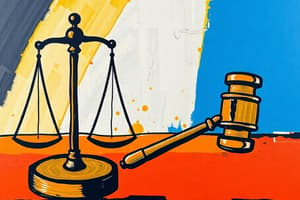Podcast
Questions and Answers
Explain how the sociological definition of crime broadens the scope of criminological inquiry compared to the legal definition.
Explain how the sociological definition of crime broadens the scope of criminological inquiry compared to the legal definition.
The sociological definition includes behaviors that may not be illegal but are still harmful or disruptive, while the legal definition is limited to acts prohibited by law.
How might the psychological and sociological perspectives on crime be integrated to explain juvenile delinquency?
How might the psychological and sociological perspectives on crime be integrated to explain juvenile delinquency?
Psychological factors such as impulsivity can combine with social factors like peer influence to drive delinquent behavior.
Contrast how a consensus perspective and a conflict perspective would explain the creation of laws against insider trading.
Contrast how a consensus perspective and a conflict perspective would explain the creation of laws against insider trading.
A consensus perspective would see it as reflecting shared values of fairness in markets, while a conflict perspective would see it as protecting the interests of wealthy investors.
How does the distinction between mala in se and mala prohibita influence moral judgments about different types of crime?
How does the distinction between mala in se and mala prohibita influence moral judgments about different types of crime?
Describe how labeling theory can explain the process by which a minor offense escalates into a pattern of criminal behavior.
Describe how labeling theory can explain the process by which a minor offense escalates into a pattern of criminal behavior.
Explain why the legal definition of crime is considered limited in fully capturing the scope and nature of harmful behaviors in society.
Explain why the legal definition of crime is considered limited in fully capturing the scope and nature of harmful behaviors in society.
Differentiate between how classical criminology and positivist criminology approach the question of criminal responsibility.
Differentiate between how classical criminology and positivist criminology approach the question of criminal responsibility.
How might a critical criminologist explain the over-representation of marginalized groups in the criminal justice system?
How might a critical criminologist explain the over-representation of marginalized groups in the criminal justice system?
Explain how strain theory accounts for the relationship between social inequality and crime rates.
Explain how strain theory accounts for the relationship between social inequality and crime rates.
Describe how social learning theory might explain why individuals from similar backgrounds can have different involvement in criminal activity.
Describe how social learning theory might explain why individuals from similar backgrounds can have different involvement in criminal activity.
If a particular harmful act is not defined as criminal, does that mean criminologists should not study it? Explain from a sociological perspective.
If a particular harmful act is not defined as criminal, does that mean criminologists should not study it? Explain from a sociological perspective.
How does the political definition of crime challenge the notion of law as a neutral arbiter of right and wrong?
How does the political definition of crime challenge the notion of law as a neutral arbiter of right and wrong?
Explain how viewing crime through an integrated definition can lead to more effective crime prevention strategies.
Explain how viewing crime through an integrated definition can lead to more effective crime prevention strategies.
Compare and contrast the roles of law enforcement, courts, and corrections within the criminal justice system.
Compare and contrast the roles of law enforcement, courts, and corrections within the criminal justice system.
Why is it important to distinguish between the legal and sociological definitions of crime when studying corporate wrongdoing?
Why is it important to distinguish between the legal and sociological definitions of crime when studying corporate wrongdoing?
How might the consensus and conflict perspectives view the implementation of mandatory minimum sentences for drug offenses differently?
How might the consensus and conflict perspectives view the implementation of mandatory minimum sentences for drug offenses differently?
Explain how mala in se crimes often have a higher level of societal response and punishment compared to mala prohibita crimes, even when the latter causes widespread harm.
Explain how mala in se crimes often have a higher level of societal response and punishment compared to mala prohibita crimes, even when the latter causes widespread harm.
How can social learning theory and strain theory be combined to better explain gang membership and criminal behavior?
How can social learning theory and strain theory be combined to better explain gang membership and criminal behavior?
Using the political definition of crime, explain how acts of civil disobedience could be considered criminal, even if they are intended to promote social justice.
Using the political definition of crime, explain how acts of civil disobedience could be considered criminal, even if they are intended to promote social justice.
Describe how changes in social norms can lead to certain behaviors being decriminalized or legalized, influencing the sociological and legal definitions of crime.
Describe how changes in social norms can lead to certain behaviors being decriminalized or legalized, influencing the sociological and legal definitions of crime.
Flashcards
Legal Definition of Crime
Legal Definition of Crime
An act or omission violating criminal law, punishable by the state.
Sociological Definition of Crime
Sociological Definition of Crime
A violation of social norms, whether legally defined as crimes or not.
Psychological Definition of Crime
Psychological Definition of Crime
Crime resulting from individual differences in behavior and personality.
Political Definition of Crime
Political Definition of Crime
Signup and view all the flashcards
Mala in se
Mala in se
Signup and view all the flashcards
Mala prohibita
Mala prohibita
Signup and view all the flashcards
Consensus Perspective
Consensus Perspective
Signup and view all the flashcards
Conflict Perspective
Conflict Perspective
Signup and view all the flashcards
Criminal Justice System
Criminal Justice System
Signup and view all the flashcards
Classical Criminology
Classical Criminology
Signup and view all the flashcards
Positivist Criminology
Positivist Criminology
Signup and view all the flashcards
Social Learning Theory
Social Learning Theory
Signup and view all the flashcards
Strain Theory
Strain Theory
Signup and view all the flashcards
Labeling Theory
Labeling Theory
Signup and view all the flashcards
Critical Criminology
Critical Criminology
Signup and view all the flashcards
Norms
Norms
Signup and view all the flashcards
Study Notes
- Criminology seeks to understand the causes, consequences, and prevention of crime
- Crime is a complex concept with various definitions and interpretations across different disciplines and perspectives
Legal Definition of Crime
- Crime is an act or omission that violates the criminal law and is punishable by the state
- The legal definition emphasizes the formal aspect of crime, focusing on what behaviors are prohibited by law
- This definition varies across jurisdictions and time periods, as laws change
- It is limited by its dependence on the existing legal framework, which may not always reflect societal values or address all forms of harm
Sociological Definition of Crime
- Crime is a violation of social norms
- Norms are rules of behavior that are considered acceptable within a society or group
- This definition broadens the scope of criminological inquiry to include behaviors that may not be legally defined as crimes but are still considered harmful or disruptive to social order
- It allows for the study of behaviors that are on the margins of legality but still raise concerns about social control and deviance
- Sociological perspectives emphasize the social construction of crime, recognizing that what is considered criminal is shaped by power dynamics, cultural values, and social context
Psychological Definition of Crime
- Crime is a result of individual differences in behavior and personality
- Psychological theories focus on the mental processes, emotional states, and behavioral patterns that contribute to criminal behavior
- This definition emphasizes the role of individual factors, such as genetics, upbringing, and personal experiences, in shaping criminal behavior
- It leads to interventions aimed at addressing individual risk factors and promoting pro-social behavior
Political Definition of Crime
- Crime is behavior that is labeled as such by those in power
- Political perspectives highlight the role of power, inequality, and social conflict in shaping the definition and enforcement of crime
- This definition emphasizes the political and economic structures that influence the criminal justice system
- It encourages critical examination of how laws are created, interpreted, and applied, and how they may reflect and reinforce existing power imbalances
- By this definition, the powerful can create laws that protect their interests and punish those who threaten them
Integrated Definitions of Crime
- Crime is a combination of legal, sociological, psychological, and political factors
- Integrated approaches recognize the complexity of crime and seek to combine insights from different disciplines to provide a more comprehensive understanding
- This definition emphasizes the importance of considering the interplay of individual, social, and structural factors in understanding and addressing crime
Mala in se and Mala prohibita
- Mala in se: acts that are inherently evil or wrong
- These crimes are considered morally reprehensible, such as murder, rape, and theft
- Mala prohibita: acts that are wrong because they are prohibited by law
- These crimes are not inherently evil but are considered illegal because they violate regulations or laws, such as traffic violations, drug possession, and certain forms of white-collar crime
- The distinction between mala in se and mala prohibita helps to clarify the moral and ethical dimensions of crime and to distinguish between acts that are universally condemned and those that are considered wrong only because they are prohibited by law
Consensus vs. Conflict Perspectives
- Consensus perspective: laws reflect the shared values and beliefs of society
- Conflict perspective: laws are created by those in power to protect their interests
- These perspectives offer contrasting views on the role of law in society and the extent to which it reflects a shared consensus or the interests of particular groups
The Criminal Justice System
- The criminal justice system is the set of agencies and processes established by governments to control crime and impose penalties on those who violate laws
- It typically includes law enforcement, courts, and corrections
- Law enforcement agencies are responsible for investigating crimes, apprehending suspects, and maintaining order
- The courts are responsible for adjudicating cases, determining guilt or innocence, and imposing sentences
- Corrections agencies are responsible for supervising and rehabilitating offenders
Theories of Crime
- Criminology encompasses a wide range of theories that seek to explain the causes of crime
- Classical criminology emphasizes free will and rational choice, arguing that individuals choose to commit crimes based on a calculation of costs and benefits
- Positivist criminology emphasizes biological, psychological, and social factors, arguing that criminal behavior is determined by forces beyond the individual's control
- Social learning theory emphasizes the role of learning and socialization in shaping criminal behavior, arguing that individuals learn to commit crimes through interactions with others
- Strain theory emphasizes the role of social and economic inequality in generating crime, arguing that individuals who are unable to achieve their goals through legitimate means may turn to crime
- Labeling theory emphasizes the role of social reaction in shaping criminal behavior, arguing that individuals who are labeled as criminals may internalize this label and engage in further criminal behavior
- Critical criminology emphasizes the role of power, inequality, and social conflict in shaping crime and the criminal justice system, arguing that crime is a product of social and economic structures
Studying That Suits You
Use AI to generate personalized quizzes and flashcards to suit your learning preferences.




